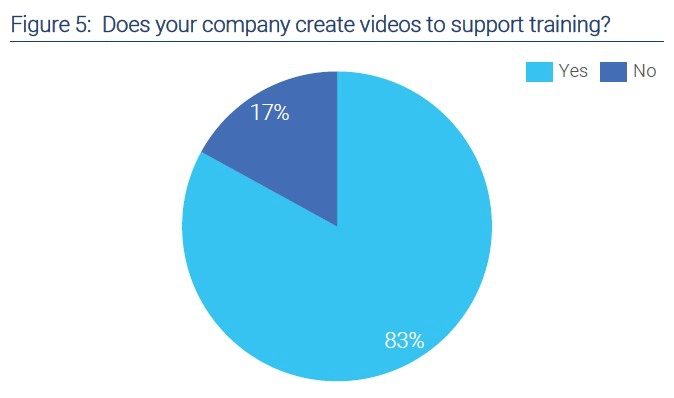6 Best Practices For Creating Enterprise Training Videos
Share on Social
Are you interested in ensuring that your staff have the best skills that they need to get their jobs done? Enterprise environments face unique challenges when it comes to employee training. While video enables them to scale their programs, training professionals have found that traditional sharing methods are not fully enabling their success. HR and training professionals in an enterprise environment need to be leveraging an enterprise video platform to ensure that employees have easy access enterprise training videos.

Training videos are popular because they can consistently demonstrate the value of various skills, retain long term value once created, are more engaging than written documents, and are better suited for globally dispersed (or remote) enterprise teams.
Training is also important for keep your employees happy. A developed employee is a happy employee and is more likely to be retained by your company. According to a 2019 turnover study, employees have been voluntarily leaving their jobs in increasing numbers, with 27% of all employees quitting their jobs in 2018.
So what makes for great enterprise training videos in 2020? That’s what we’re here to show you.
In this guide, we’ll take a closer look at how to make enterprise training videos that will entertain, educate, and inspire your talent.
1. Prioritize a Topic
Choosing a topic is very important when it comes to training videos. Make sure that you choose a relevant topic and one that will peak employees’ interest. The subject shouldn’t be too obscure, otherwise, people may not wish to consume it. Define who is going to be watching this video and what do they need to know? Our research shows that the five most popular training videos encompass the following categories:
- Job Skills Training
- Onboarding / New Hire Training
- Compliance Training
- Leadership Development
- Safety Training
It’s always a good idea to conduct first-hand research by reaching out to the employees and internal subject matter experts directly in order to develop content. Often, these subject matter experts can help with the creation of the video – either by making an appearance or by developing the narration and content.
2. Prepare Your Equipment
Before you can record your video, make sure that you have everything that you need. If you have a modern video Content Management System with single sign-on capabilities, authorized employees can capture and ingest videos from any device or platform that they need to. This can be on a laptop, a phone, a tablet, conference system, etc.
Here are some items that you will need to create a quality video.
- An HD camera (see if your laptop has this built-in)
- Microphone (Audio should be high quality, clear, with plenty of volume)
- Adequate lighting
- The ability to process and edit the video afterwards
3. Preparation Means Great Enterprise Training Videos
 Perfect preparation prevents poor performance. Before you or any of your employees begin making a video, they should ensure that they have refined scripts or slides ready to practice. In order for a training video to retain high value over a long “shelf life” a majority of work should go into refining and polishing the content and delivery.
Perfect preparation prevents poor performance. Before you or any of your employees begin making a video, they should ensure that they have refined scripts or slides ready to practice. In order for a training video to retain high value over a long “shelf life” a majority of work should go into refining and polishing the content and delivery.
If you want to share slides with employees as part of the video, you will need to ensure that you are sharing your screen as part of the video. It is also wise to offer these slides as a separate document that can be downloaded at a later date.
You should try to ensure that your format throughout the video is consistent. Leaping from a shared screen to a presenter-led style training video is easier than many other transitions but still requires careful planning. Try to stick to a consistent theme as much as possible.
Also, be sure that the content strikes the balance of being concise while, also, being informative. The goal is to ensure that the viewers are engaged and have enough information so that they are enhancing their knowledge. Some skills can be taught through short videos that are less than a minute long. Other skills may take hours in order to properly cover in detail. If your skill is one of that requires a longer amount of time, be sure to break it down into manageable portions so trainees can take breaks or split it up over multiple days.
4. Recording and Editing Your Video
Recording your video is a detailed process. Make sure that you’re engaging or your point may get lost. Best practices here include:
- Disrupt your visuals by switching camera angles or changing still graphics
- Two narrators are much better than one
- Use music as appropriate
- Make sure that the content solves a problem
- Do everything in moderation
Another way to keep your video engaging, you can consider adding some text to the video. You do not want it to become an essay but some concise text will a long way. Some examples of text that you can add to your training videos can include:
- Bullet points of key takeaways for a section. This will improve comprehension of your subject matter
- Annotations that focus the viewer’s gaze on a particular element of the screen. This can be used when going over a dense and technical aspect of training
- Text overlays or interstitial shots can detail complex information in an easier and more engaging way, and will also assist people visually searching through video for a particular topic
Another way to make sure that the video is engaging is to add some visuals and animations to the video. While even transitional animations can help make the video more engaging for the viewer, having professional quality animation made is actually an attractive economic option over live video with actors and should be explored if appropriate.
Another consideration when recording your training video is what kind of screen will be used. Will users primarily use their laptops or their phones? The answer to this should influence the dimensions of the final video, the size and quantity of the text used, and how much you should zoom into key visual details.
Once you have your video captured, be sure to edit out mistakes, hiccups, or irrelevant moments from it to create a more streamlined and polished video. Also be sure to index the key topics by time in longer videos to enable users to search for precisely what they need (or split into smaller videos if needed).
5. Uploading the Video
When you complete the creation of the video, you’ll need to upload it to the enterprise video CMS for easy consumption and integration into key systems across the organization. The Vbrick enterprise video platform features access control and single sign-on (SSO) features, ensuring that videos are only shown to people who need to see them. This keeps security tight, ensures that users are not overwhelmed with irrelevant content, and will not require an entire training video itself in order to use with ease (unlike many enterprise knowledge management solutions).
6. Review and Repeat
How was your video received? Were people engaged? At what point did your video lose some of the audience? An enterprise video platform will feature analytics so you can answer these questions with confidence. Analytics give you instant feedback and are more reliable than conducting a survey. Analytics can provide clarity on engagement and can allow you to focus on next steps – whether it’s further refinement of the current messaging or if it makes sense to add follow-on topics.
Realistically each video you make, you will ultimately learn some things you could do better next time. After finding out what the weak points were and what your employees liked most about it, be sure to apply this learning in the form of improvements for your next training video.
Iterate on every video and try to make it even better than the one that came before it (don’t become formulaic). Also be sure to keep your video cadence going, as it is much more realistic to consistently spend a portion of your weekly bandwidth towards video creation than it is to try to do a year’s worth of videos in an uninterrupted project.
How Can Vbrick Help?
The Top 3 Obstacles of Enterprise Training Videos in 2020
- Having the proper resources and systems for video creation
- Knowing if people are engaged in the video
- Finding time to create video
Making enterprise training videos isn’t easy and ensuring they are consumed can be even more demanding. Having a comprehensive enterprise video platform will allow teams to easily create and share from within the same platform. Enterprise organizations will also appreciate that their system is secured by their single sign-on (SSO) system, and analytics on individual consumption and engagement are available to ensure compliance.



